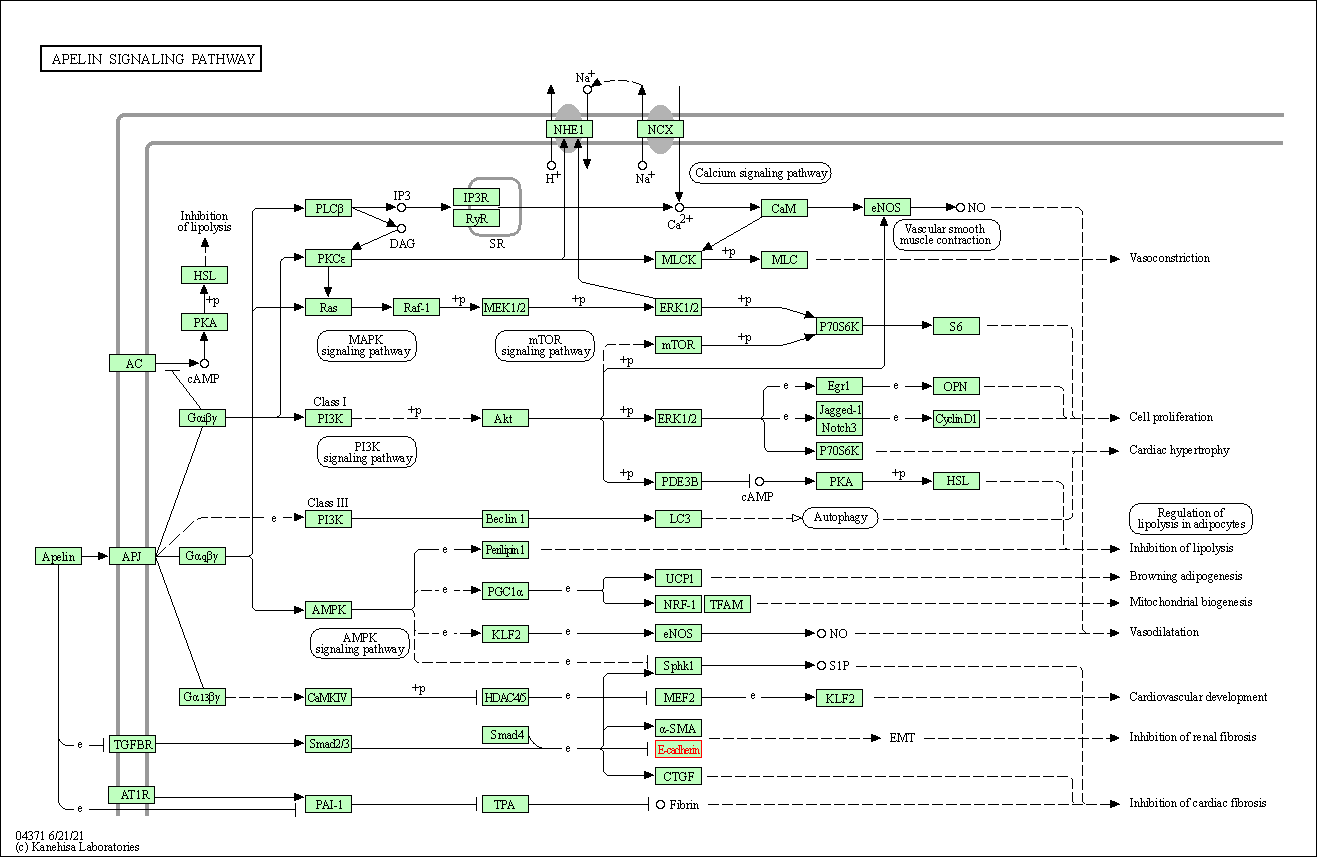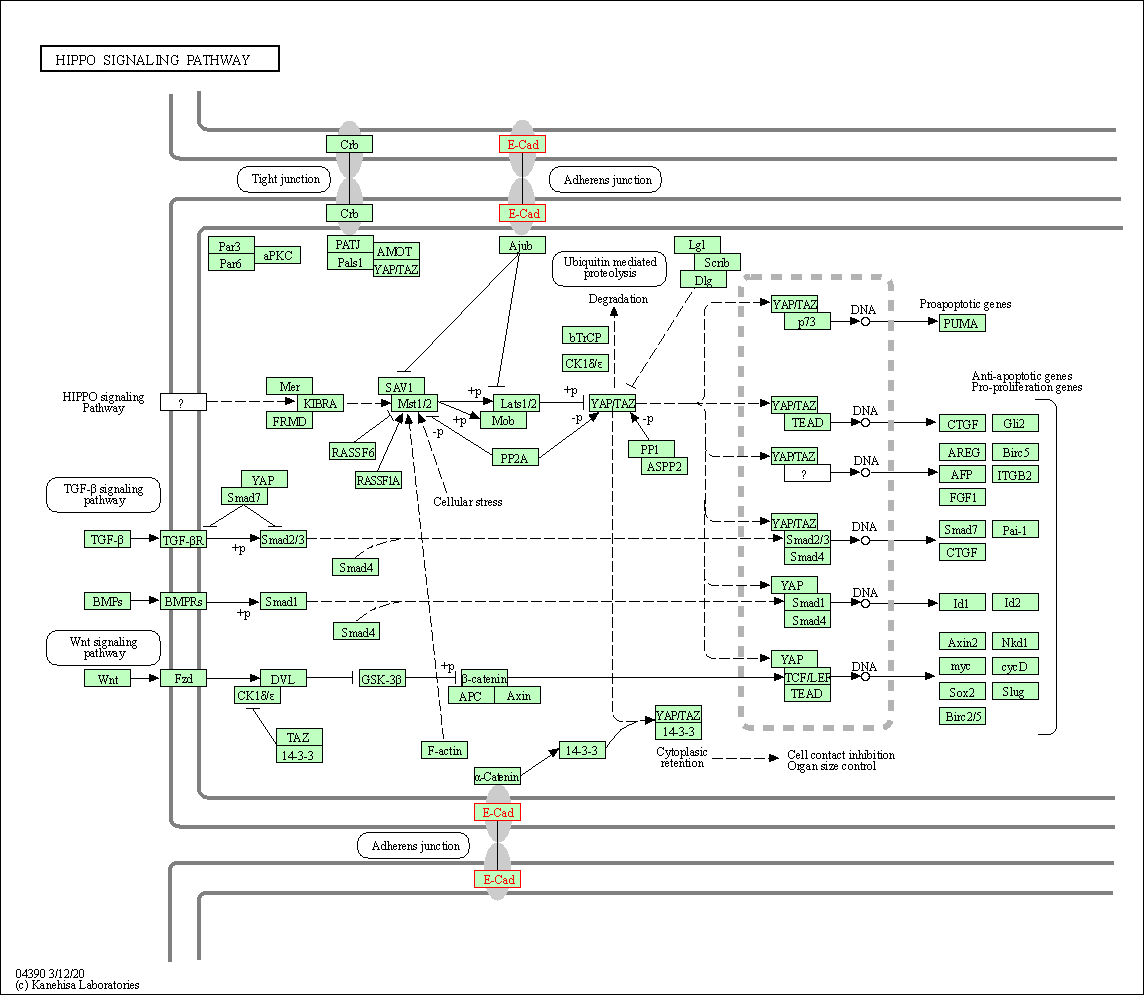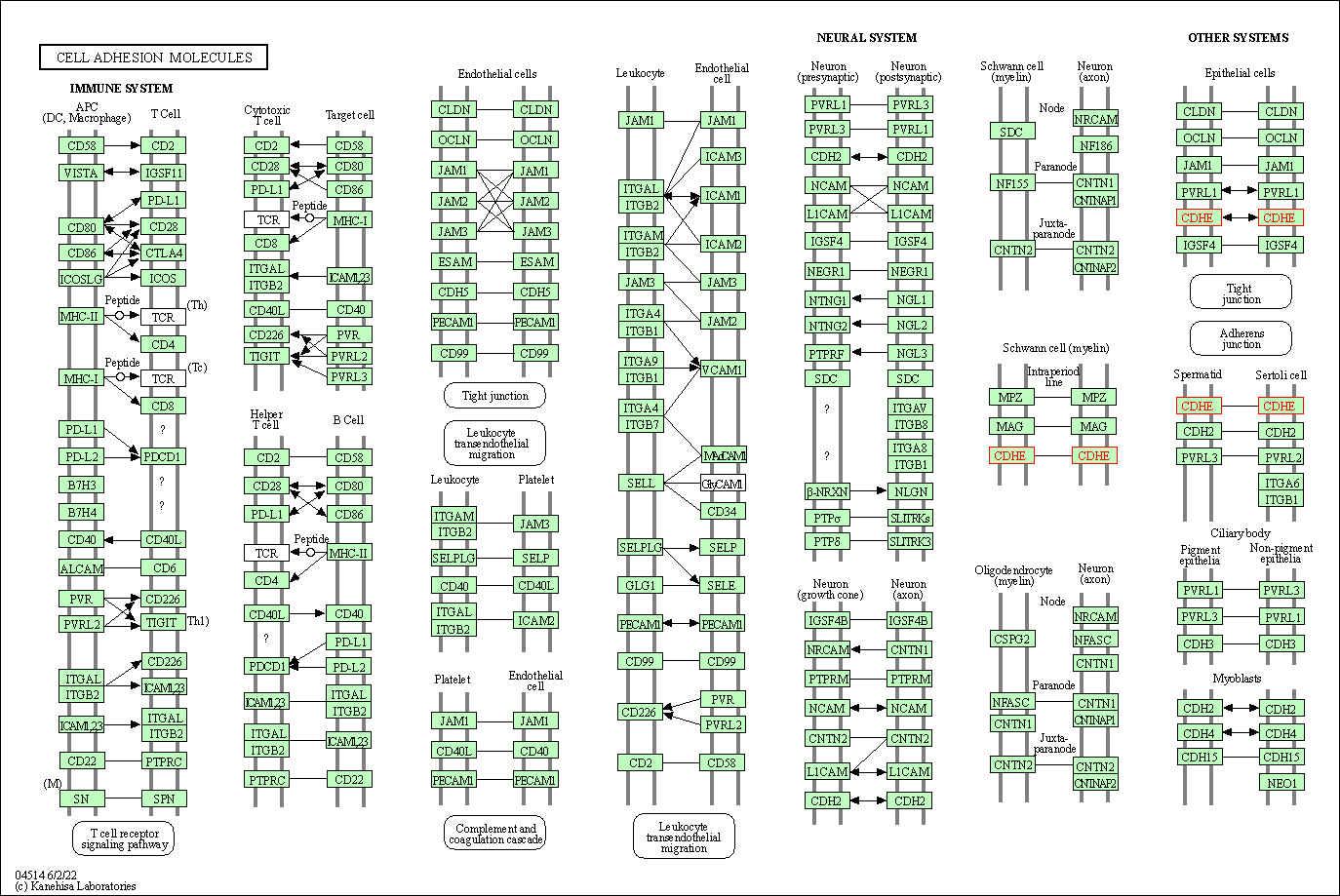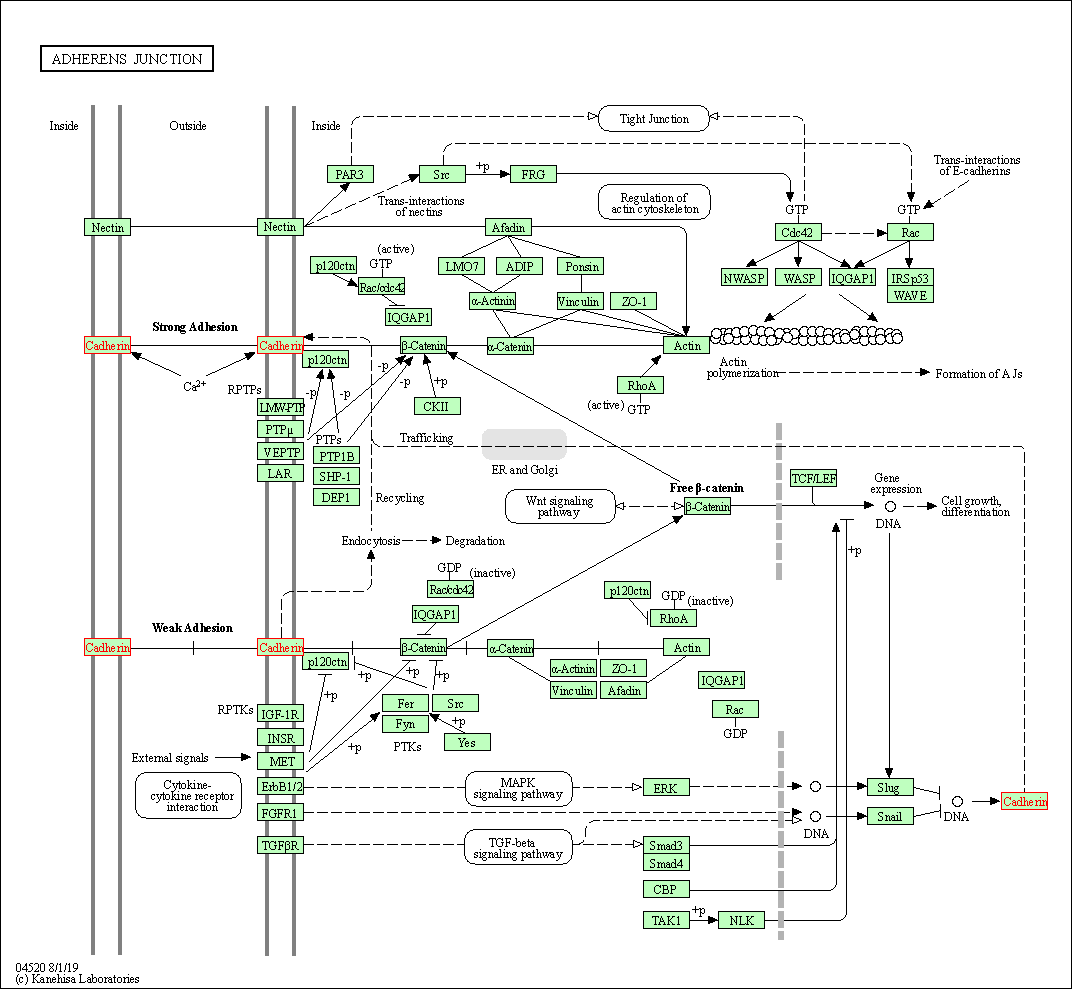Target Information
| Target General Information | Top | |||||
|---|---|---|---|---|---|---|
| Target ID |
T08919
(Former ID: TTDR01008)
|
|||||
| Target Name |
Epithelial cadherin (CDH1)
|
|||||
| Synonyms |
Uvomorulin; UVO; E-cadherin gene; E-cadherin; Cadherin-1; CDHE; CD324; CAM 120/80
Click to Show/Hide
|
|||||
| Gene Name |
CDH1
|
|||||
| Target Type |
Literature-reported target
|
[1] | ||||
| Function |
Cadherins are calcium-dependent cell adhesion proteins. They preferentially interact with themselves in a homophilic manner in connecting cells; cadherins may thus contribute to the sorting of heterogeneous cell types. CDH1 is involved in mechanisms regulating cell-cell adhesions, mobility and proliferation of epithelial cells. Has a potent invasive suppressor role. It is a ligand for integrin alpha-E/beta-7.
Click to Show/Hide
|
|||||
| UniProt ID | ||||||
| Sequence |
MGPWSRSLSALLLLLQVSSWLCQEPEPCHPGFDAESYTFTVPRRHLERGRVLGRVNFEDC
TGRQRTAYFSLDTRFKVGTDGVITVKRPLRFHNPQIHFLVYAWDSTYRKFSTKVTLNTVG HHHRPPPHQASVSGIQAELLTFPNSSPGLRRQKRDWVIPPISCPENEKGPFPKNLVQIKS NKDKEGKVFYSITGQGADTPPVGVFIIERETGWLKVTEPLDRERIATYTLFSHAVSSNGN AVEDPMEILITVTDQNDNKPEFTQEVFKGSVMEGALPGTSVMEVTATDADDDVNTYNAAI AYTILSQDPELPDKNMFTINRNTGVISVVTTGLDRESFPTYTLVVQAADLQGEGLSTTAT AVITVTDTNDNPPIFNPTTYKGQVPENEANVVITTLKVTDADAPNTPAWEAVYTILNDDG GQFVVTTNPVNNDGILKTAKGLDFEAKQQYILHVAVTNVVPFEVSLTTSTATVTVDVLDV NEAPIFVPPEKRVEVSEDFGVGQEITSYTAQEPDTFMEQKITYRIWRDTANWLEINPDTG AISTRAELDREDFEHVKNSTYTALIIATDNGSPVATGTGTLLLILSDVNDNAPIPEPRTI FFCERNPKPQVINIIDADLPPNTSPFTAELTHGASANWTIQYNDPTQESIILKPKMALEV GDYKINLKLMDNQNKDQVTTLEVSVCDCEGAAGVCRKAQPVEAGLQIPAILGILGGILAL LILILLLLLFLRRRAVVKEPLLPPEDDTRDNVYYYDEEGGGEEDQDFDLSQLHRGLDARP EVTRNDVAPTLMSVPRYLPRPANPDEIGNFIDENLKAADTDPTAPPYDSLLVFDYEGSGS EAASLSSLNSSESDKDQDYDYLNEWGNRFKKLADMYGGGEDD Click to Show/Hide
|
|||||
| 3D Structure | Click to Show 3D Structure of This Target | AlphaFold | ||||
| HIT2.0 ID | T94H37 | |||||
| Cell-based Target Expression Variations | Top | |||||
|---|---|---|---|---|---|---|
| Cell-based Target Expression Variations | ||||||
| Drug Binding Sites of Target | Top | |||||
|---|---|---|---|---|---|---|
| Ligand Name: Alpha-D-Mannose | Ligand Info | |||||
| Structure Description | Crystal Structure of Human E-cadherin EC1-5 bound by mouse monoclonal antibody Fab mAb-1_19A11 | PDB:7STZ | ||||
| Method | X-ray diffraction | Resolution | 2.95 Å | Mutation | No | [2] |
| PDB Sequence |
DWVIPPISCP
10 ENEKGPFPKN20 LVQIKSNKDK30 EGKVFYSITG40 QGADTPPVGV50 FIIERETGWL 60 KVTEPLDRER70 IATYTLFSHA80 VSSNGNAVED90 PMEILITVTD100 QNDNKPEFTQ 110 EVFKGSVMEG120 ALPGTSVMEV130 TATDADDDVN140 TYNAAIAYTI150 LSQDPELPDK 160 NMFTINRNTG170 VISVVTTGLD180 RESFPTYTLV190 VQAADLQGEG200 LSTTATAVIT 210 VTDTNDNPPI220 FNPTTYKGQV230 PENEANVVIT240 TLKVTDADAP250 NTPAWEAVYT 260 ILNDDGGQFV270 VTTNPVNNDG280 ILKTAKGLDF290 EAKQQYILHV300 AVTNVVPFEV 310 SLTTSTATVT320 VDVLDVNEAP330 IFVPPEKRVE340 VSEDFGVGQE350 ITSYTAQEPD 360 TFMEQKITYR370 IWRDTANWLE380 INPDTGAIST390 RAELDREDFE400 HVKNSTYTAL 410 IIATDNGSPV420 ATGTGTLLLI430 LSDVNDNAPI440 PEPRTIFFCE450 RNPKPQVINI 460 IDADLPPNTS470 PFTAELTHGA480 SANWTIQYND490 PTQESIILKP500 KMALEVGDYK 510 INLKLMDNQN520 KDQVTTLEVS530 VCDCEGAAGV540
|
|||||
|
|
||||||
| Ligand Name: Beta-D-Mannose | Ligand Info | |||||
| Structure Description | Crystal Structure of Human E-cadherin EC1-5 bound by mouse monoclonal antibody Fab mAb-1_19A11 | PDB:7STZ | ||||
| Method | X-ray diffraction | Resolution | 2.95 Å | Mutation | No | [2] |
| PDB Sequence |
DWVIPPISCP
10 ENEKGPFPKN20 LVQIKSNKDK30 EGKVFYSITG40 QGADTPPVGV50 FIIERETGWL 60 KVTEPLDRER70 IATYTLFSHA80 VSSNGNAVED90 PMEILITVTD100 QNDNKPEFTQ 110 EVFKGSVMEG120 ALPGTSVMEV130 TATDADDDVN140 TYNAAIAYTI150 LSQDPELPDK 160 NMFTINRNTG170 VISVVTTGLD180 RESFPTYTLV190 VQAADLQGEG200 LSTTATAVIT 210 VTDTNDNPPI220 FNPTTYKGQV230 PENEANVVIT240 TLKVTDADAP250 NTPAWEAVYT 260 ILNDDGGQFV270 VTTNPVNNDG280 ILKTAKGLDF290 EAKQQYILHV300 AVTNVVPFEV 310 SLTTSTATVT320 VDVLDVNEAP330 IFVPPEKRVE340 VSEDFGVGQE350 ITSYTAQEPD 360 TFMEQKITYR370 IWRDTANWLE380 INPDTGAIST390 RAELDREDFE400 HVKNSTYTAL 410 IIATDNGSPV420 ATGTGTLLLI430 LSDVNDNAPI440 PEPRTIFFCE450 RNPKPQVINI 460 IDADLPPNTS470 PFTAELTHGA480 SANWTIQYND490 PTQESIILKP500 KMALEVGDYK 510 INLKLMDNQN520 KDQVTTLEVS530 VCDCEGAAGV540
|
|||||
|
|
GLU111
3.034
VAL112
3.958
SER126
1.502
VAL127
3.213
MET128
3.783
GLU129
3.166
VAL171
3.916
THR188
4.732
VAL190
3.654
ALA205
4.119
THR206
1.437
THR224
3.953
THR225
3.531
HIS299
4.435
THR303
3.622
PHE308
4.740
LEU312
3.525
|
|||||
| Click to View More Binding Site Information of This Target with Different Ligands | ||||||
| Different Human System Profiles of Target | Top |
|---|---|
|
Human Similarity Proteins
of target is determined by comparing the sequence similarity of all human proteins with the target based on BLAST. The similarity proteins for a target are defined as the proteins with E-value < 0.005 and outside the protein families of the target.
A target that has fewer human similarity proteins outside its family is commonly regarded to possess a greater capacity to avoid undesired interactions and thus increase the possibility of finding successful drugs
(Brief Bioinform, 21: 649-662, 2020).
Human Tissue Distribution
of target is determined from a proteomics study that quantified more than 12,000 genes across 32 normal human tissues. Tissue Specificity (TS) score was used to define the enrichment of target across tissues.
The distribution of targets among different tissues or organs need to be taken into consideration when assessing the target druggability, as it is generally accepted that the wider the target distribution, the greater the concern over potential adverse effects
(Nat Rev Drug Discov, 20: 64-81, 2021).
Human Pathway Affiliation
of target is determined by the life-essential pathways provided on KEGG database. The target-affiliated pathways were defined based on the following two criteria (a) the pathways of the studied target should be life-essential for both healthy individuals and patients, and (b) the studied target should occupy an upstream position in the pathways and therefore had the ability to regulate biological function.
Targets involved in a fewer pathways have greater likelihood to be successfully developed, while those associated with more human pathways increase the chance of undesirable interferences with other human processes
(Pharmacol Rev, 58: 259-279, 2006).
Biological Network Descriptors
of target is determined based on a human protein-protein interactions (PPI) network consisting of 9,309 proteins and 52,713 PPIs, which were with a high confidence score of ≥ 0.95 collected from STRING database.
The network properties of targets based on protein-protein interactions (PPIs) have been widely adopted for the assessment of target’s druggability. Proteins with high node degree tend to have a high impact on network function through multiple interactions, while proteins with high betweenness centrality are regarded to be central for communication in interaction networks and regulate the flow of signaling information
(Front Pharmacol, 9, 1245, 2018;
Curr Opin Struct Biol. 44:134-142, 2017).
Human Similarity Proteins
Human Tissue Distribution
Human Pathway Affiliation
Biological Network Descriptors
|
|
|
There is no similarity protein (E value < 0.005) for this target
|
|
Note:
If a protein has TS (tissue specficity) scores at least in one tissue >= 2.5, this protein is called tissue-enriched (including tissue-enriched-but-not-specific and tissue-specific). In the plots, the vertical lines are at thresholds 2.5 and 4.
|





| KEGG Pathway | Pathway ID | Affiliated Target | Pathway Map |
|---|---|---|---|
| Rap1 signaling pathway | hsa04015 | Affiliated Target |

|
| Class: Environmental Information Processing => Signal transduction | Pathway Hierarchy | ||
| Apelin signaling pathway | hsa04371 | Affiliated Target |

|
| Class: Environmental Information Processing => Signal transduction | Pathway Hierarchy | ||
| Hippo signaling pathway | hsa04390 | Affiliated Target |

|
| Class: Environmental Information Processing => Signal transduction | Pathway Hierarchy | ||
| Cell adhesion molecules | hsa04514 | Affiliated Target |

|
| Class: Environmental Information Processing => Signaling molecules and interaction | Pathway Hierarchy | ||
| Adherens junction | hsa04520 | Affiliated Target |

|
| Class: Cellular Processes => Cellular community - eukaryotes | Pathway Hierarchy | ||
| Degree | 53 | Degree centrality | 5.69E-03 | Betweenness centrality | 4.48E-03 |
|---|---|---|---|---|---|
| Closeness centrality | 2.59E-01 | Radiality | 1.45E+01 | Clustering coefficient | 9.87E-02 |
| Neighborhood connectivity | 3.73E+01 | Topological coefficient | 3.82E-02 | Eccentricity | 11 |
| Download | Click to Download the Full PPI Network of This Target | ||||
| Target Regulators | Top | |||||
|---|---|---|---|---|---|---|
| Target-regulating microRNAs | ||||||
| Target-interacting Proteins | ||||||
| References | Top | |||||
|---|---|---|---|---|---|---|
| REF 1 | The role of the E-cadherin gene (CDH1) in diffuse gastric cancer susceptibility: from the laboratory to clinical practice. Ann Oncol. 2003 Dec;14(12):1705-13. | |||||
| REF 2 | Regulation of multiple dimeric states of E-cadherin by adhesion activating antibodies revealed through Cryo-EM and X-ray crystallography. PNAS Nexus. 2022 Aug 19;1(4):pgac163. | |||||
If You Find Any Error in Data or Bug in Web Service, Please Kindly Report It to Dr. Zhou and Dr. Zhang.

